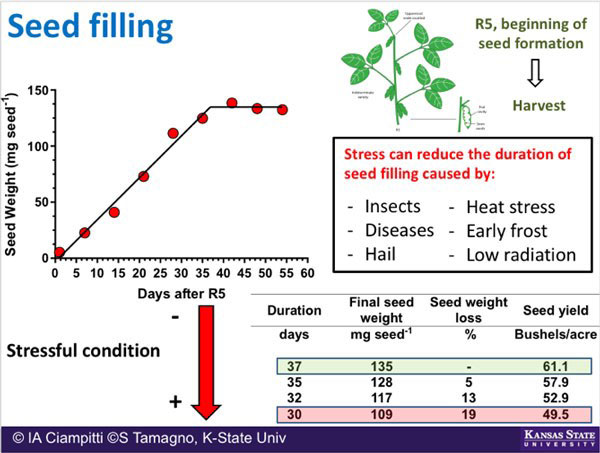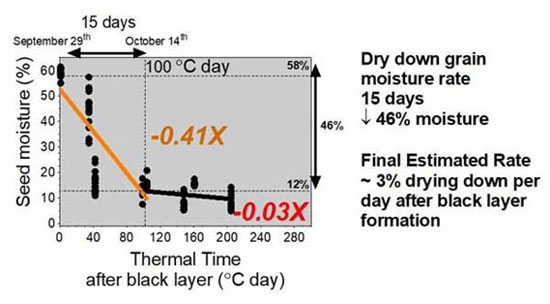The latest USDA-National Agricultural Statistics Service crop progress and condition report, released September 8, 2024, classified 78% of the soybean crop as being in fair (30%) or good (48%) condition. Overall, 23% of all soybeans in Kansas are dropping leaves, below last year's (32%) but ahead of the 5-year average (20%).
Weather outlook
The weather conditions expected for the last portion of September will be critical for soybeans as they relate to seed filling and determining the final seed weight.
Temperatures in September have averaged slightly below normal across the state, but warmer weather has returned this week and is forecast to persist into next week. Precipitation has been below normal across almost all of the state, with just a few areas above normal, specifically the McPherson and Emporia areas, where isolated storms brought significant rainfall earlier this month. Precipitation next week is forecast to be below normal, with elevated chances for above-normal precipitation the following week. Seasonally, we continue the weekly decrease in normal precipitation as we head towards the driest season of the year (winter). As a result, below-average precipitation means potentially very little, if any, moisture. Warm and dry conditions will favor overall low humidity, increasing drought, and wide day/night temperature swings.
Soybean seed-filling
Final maturity is defined as the formation of the black layer in the seeds. Soybeans will reach final maturity with high seed water content, moving from 75-80% (R6) to around 50% (R7) from the beginning of seed filling until final maturity (Figure 1). Seed dry matter accumulation and moisture changes will depend on the maturity group (affecting the length of the season), planting date, and weather conditions experienced during the latter part of the reproductive phase.
Soybean seed water loss can divided into two main phases: 1) before “black layer” or maturity, and 2) after black layer.
The overall contribution of seed weight to final yields can be studied by evaluating changes in seed weight during the seed-filling period (Figure 2). Overall, a seed-filling period of more than one month (37 days) duration until black layer was achieved (this is the reference for changes in seed weight). The graph of seed filling provides a visual of the overall rate, increase in seed weight per day, and the duration of the seed filling.
From this example, we can observe that when the duration is reduced by one week (from 37 to 30 days), the attainable yield goes from 61 to roughly 50 bushels per acre. Potential factors impacting the duration (beyond the current heat/drought) of leaf green area imposed by insects, diseases, hailstorms, and any other abiotic stress conditions such as cloudy days and early frost impacting the crop during the coming weeks will negatively affect the seed filling conditions for soybeans.
For this current season, we can largely expect negative yield impacts due to the last heat wave combined with drought conditions, which resulted in poor seed weight and potentially increased late pods and seeds’ abortion. Overall, seed weight contributes roughly 30-40% of the final total yield for this crop, emphasizing the impacts of the stress conditions on the attainable yields.

Figure 1. Soybean seed filling process from full seed to full maturity. Photo and infographic prepared by Ignacio Ciampitti, K-State Research and Extension. Taken from Soybean Growth and Development, MF3339.

Figure 2. Soybean seed weight changes from the beginning of seed filling (R5) to full maturity. Photo and infographic prepared by Ignacio Ciampitti and Santiago Tamagno, K-State Research and Extension.
Soybean dry down
Soybeans reach final maturity with high seed water content, moving from 90% to around 60% from the beginning of seed filling until final maturity. Final maturity is defined as the formation of the black layer in the seeds. The dry down rate will depend on the maturity group (affecting the length of the season), planting date, and weather conditions experienced during the latter part of the reproductive phase.
To address the question related to the dry down rate for soybeans, a study was conducted to investigate the changes in water content from black layer formation (maturity) until harvest time (Figure 3). During the last days of September and mid-October 2016, the overall dry down rate was around 3% per day (from 58% to 12% seed moisture) – taking an overall period of 15 days.

Figure 3. Grain moisture dry down (orange line) across three hybrids and different N rates near Manhattan, KS. Horizontal dashed lines marked the 58% seed moisture at black layer formation. * Graph prepared by Ignacio Ciampitti, K-State Research and Extension.
*Note: To maximize the final seed volume to be sold, it is desired to reach harvest with 13% seed moisture, thus the importance of timing harvest with the right seed moisture content.
Soybean dry down rate was three times faster, at 3% per day, relative to corn, at 1% per day. These dry down rates for corn and soybeans are primarily affected by temperature, humidity, and overall water content at the point of black layer formation (maturity). These main factors should be considered when scheduling the soybean harvest.
With the current weather conditions, soybeans entering maturity could be ready to harvest in less than two weeks. Therefore, scout your fields to check for maturity and prioritize situations with lodging or other stress factor that could compromise plant standability, ultimately affecting seed quality.
Ignacio A. Ciampitti, Farming Systems
ciampitti@ksu.edu
Matthew Sittel, Assistant State Climatologist
msittel@ksu.edu